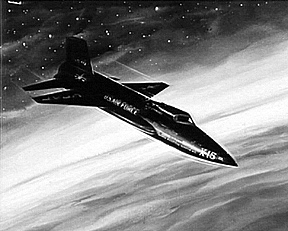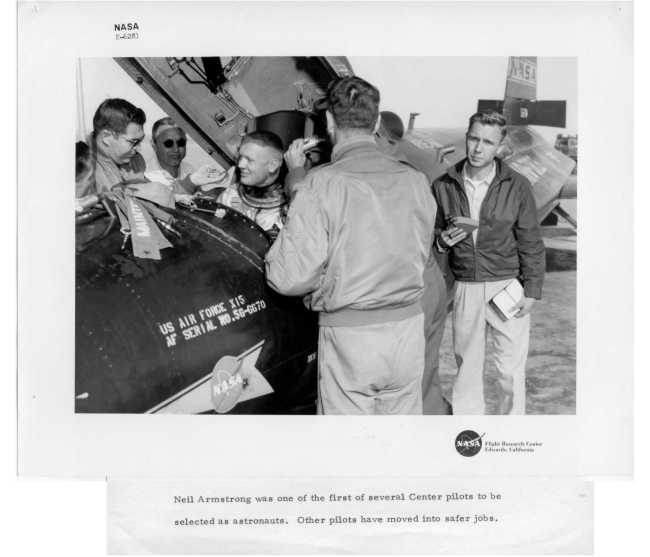
Neil Armstrong's reentry skip
...

Neil Armstrong's reentry
skip
...
To the edge of space and to the edge of Los Angeles
| Maximum altitude | 207,500 feet |
| Maximum speed | Mach 5.31 3,789 mph |
| Flight duration | 12 min. 28.7 sec. |
| Rocket burn | 82.4 sec |
Neil Armstrong's first space flights were in the X-15, before he joined the astronaut corps. His credits included first-flight of the #3 X-15, first flight using the ball nose ("q-ball" air data sensor), and initial checkout of the MH-96 flight controller. Flight 51 was an MH-96 checkout.
The MH-96 was an experimental adaptive controller on the #3 X-15. The first two X-15's gave the pilot a right-hand sidestick and a center stick for aerodynamic flight controls, a left-hand sidestick for reaction controls outside the atmosphere, and a separate stability augmentation system. The MH-96 integrated all of these functions into one device, controlled by the right-hand sidestick.Flight 51, an MH-96 evaluation, was officially flight 3-4-8: #3 aircraft, 4'th free flight, 8'th flight altogether, including captive carries and aborts. The plan called for a step up in altitude to 205,000 feet following the preceding flight's top at 180,000 feet. The air launch occurred over Mud Dry Lake, in Nevada.The MH-96 noted how responsive the aircraft was to aerodynamic controls, using stabilator and rudder to control attitude, and adaptively changed control response to suit flight conditions. In dense low-altitude air it used low gains: A given stick movement produced a relatively small control surface deflection. In the thin air of high altitudes it produced larger control surface deflection for the same stick input. When the air was too thin for these controls to work it used the same sidestick to operate reaction controls, the small hydrogen peroxide thrusters located in the nose and the wings. While leaving or reentering the atmosphere it automatically balanced and blended use of the two types of controls.
Before launching at 45,000 feet the B-52 and the X-15 encountered unusual turbulence, "the most severe I have had to ride through in the B-52", said Armstrong in his post-flight pilot's comments. Otherwise, preflight and launch went fairly smoothly.
After launch Armstrong pulled up into the initial climb, reaching 32 degrees nose-high pitch attitude after 35 seconds of flight. The climb involved a 0 g pushover-over check with the MH-96 in alpha-hold mode (alpha is angle of attack), followed by a pitch-up to return to a 32-degree climb. Just before the second pitch-up, the speed check at 50 seconds of flight time showed 3,100 feet per second, 2,113 m.p.h.
Climb angle was somewhat in doubt, with aircraft instruments showing 30 to 30.5 degrees while NASA's ground station showed a slightly higher angle. Armstrong quickly decided quickly to fly the climb at 30.5 degrees as indicated by his instruments and held this angle until engine burnout at 82 seconds.
Precision piloting was essential in X-15 flights. A deviation of a fraction of one degree in pitch, a fraction of one second in engine burn time, and ordinary variability in rocket engine performance could produce multi-mile overshoots or undershoots in altitude or substantial overshoots or undershoots in speed. Flights gathering aerodynamic data usually needed both altitude and speed controlled very precisely in order to accomplish their test objectives. This degree of control was challenging in an aircraft whose acceleration started at 2 g's full fuel at launch and built to over 4 g's as it consumed about 18,000 pounds of ammonia and liquid oxygen, more than its own empty weight.The X-15 validated Armstrong's decision on pitch attitude by achieving a peak altitude of 207,500 feet at the top of its ballistic arc, a good match for the plan of 205,000 feet. Speed was also precise, data reduction later showed a maximum of Mach 5.31 on a plan of 5.35. Armstrong performed a number of stability and control checks to test the MH-96 in air so thin that for all practical purposes it's the vacuum of space. Air pressure at this flight's peak altitude is about 0.01% (1/10,000) of sea-level pressure.
Good flight so far, now for the adventure...From engine burnout to mid-reentry radio contact
 was marginal to
nonexistent. NASA-1, the ground station, was inaudible from the
X-15 and relays from the B-52 were weak. Reaction controls worked
well under direction from the MH-96, but the excellent attitude control
apparently sent more hydrogen peroxide through the thrusters than
expected. As the X-15 descended through about 160,000 feet a
warning light came on
indicating low hydrogen peroxide supply for the #1 APU. Armstrong
initiated transfer of residual hydrogen peroxide from the engine
turbopump supply,
and the warning light extinguished at about 115,000 feet. At
about
90,000 feet smoke poured into the cockpit from above the instrument
panel
as atmospheric reentry heating burned off paint.
was marginal to
nonexistent. NASA-1, the ground station, was inaudible from the
X-15 and relays from the B-52 were weak. Reaction controls worked
well under direction from the MH-96, but the excellent attitude control
apparently sent more hydrogen peroxide through the thrusters than
expected. As the X-15 descended through about 160,000 feet a
warning light came on
indicating low hydrogen peroxide supply for the #1 APU. Armstrong
initiated transfer of residual hydrogen peroxide from the engine
turbopump supply,
and the warning light extinguished at about 115,000 feet. At
about
90,000 feet smoke poured into the cockpit from above the instrument
panel
as atmospheric reentry heating burned off paint.
Neil Armstrong did additional stability and control checks as the X-15 re-entered the atmosphere, testing roll maneuvers at high angles of attack (AOA). He flew about 15 to 16 degrees AOA as forces built to 4 g's. The MH-96 has a load limiting function that should trip in the range of 4 to 4 1/2 g's, commanding a reduction in pitch attitude to avoid excessive g forces. In Armstrong's own words...
"I elected to leave the angle of attack in that mode [15-16 degrees] ... it wasn't obvious that we were having any g limiting so I left it at this 4 g level for quite a long time hoping that this g limiting might show up. It did not and apparently this where we got into the ballooning situation."
Due to maintaining a high angle of attack the X-15 pulled up and essentially skipped off the top of the atmosphere, returning to space. In this near-vacuum there was insufficient drag to slow it and the wings could not develop enough aerodynamic force to turn it. Back to Neil Armstrong's description...
"At this point I heard the second transmission from NASA 1. ...I expected from my simulation work 'you're about 20 miles north,' but the transmission I got was "turn hard left."
"...With the left turn command which I followed with 60 degrees left bank angle and 15 degrees angle of attack, I did not properly appreciate the altitude I was at. I was apparently at an altitude above that which I had expected to be and which caused me to go sailing merrily by the field."
X-15 approaches normally were from the north, with a 360-degree spiral to final approach starting from about 20,000 to 30,000 feet and ending with a touchdown on Rogers Dry Lake. On this flight the X-15 cruised by with excess energy, too high and too fast to enter the approach spiral. Going south past the base at about 1 mile every 2 seconds, the flight path passed the Mojave Desert towns of Lancaster and Palmdale. Beyond Palmdale are the San Gabriel Mountains, and beyond them is the Los Angeles basin."As I saw Palmdale going by I was in a 90 degree bank angle and essentially full deflection on the stabilizers... We were having no heading change. The proper thing to do at that point would have been to roll to a greater bank angle [than 90 degrees, rolling somewhat inverted] and try to get that thing down to a lower altitude so I could turn faster. However, my indicated airspeed said 190 knots and that seemed from my past simulation experience to be what should have been adequate to turn the heading but it really wasn't. Finally I did allow the nose to drift down and picked up approximately 350 knots indicated airspeed and was able to get about 3 g at this point."
This point was roughly over Pasadena, La Canada, and the RoseThe X-15 was now far to the south of its intended landing site but was at least pointed back toward the Mojave Desert. The X-15's lift to drag ratio is about 4:1, and glide ratio = L/D: It will drop one mile for every four miles it travels when its speed is steady. The normal landing area on Rogers Dry Lake was out of range, so the new challenge is to choose an alternate site that can support a high-speed landing and a long ground run.Bowl, 45 miles south of Edwards Air Force Base! This is the northern edge of the Los Angeles Basin, on the south side of the San Gabriel Mountains.
If not for that 3 g turn Armstrong's next radio contact might have needed to sound something like this: "Los Angeles Approach, X-15 66672 needs immediate clearance for straight-in approach to runway 25 Right at LAX."
Armstrong quickly considered and rejected the long runway at Palmdale, El Mirage Dry Lake to the east, and Rosamond Dry Lake to the West. He settled on stretching his glide to the south lakebed at Edwards. Two chase planes joined up as Armstrong was lining up for a straight-in approach, aiming for the middle of the south lakebed. The farther they went, the shorter it seemed the glide would be. The X-15 finally landed successfully on the lakebed -- and when one of the chase pilots was asked how much clearance there was with the Joshua trees at the edge of the lakebed his answer was "Oh, at least 100 feet ... on either side".
The flight ended 12 minutes, 28.7 seconds after it started, the
longest X-15 flight of the entire research program.
Technical flight summary, (final draft of pilot report?) scanned as text file
Pilot's comments, scanned as text plus one image
Radio communications transcript, scanned as text
 Flight summary form
Flight summary form
 Planned flight path
Planned flight path
Flight 51 request form: page 1: page 2:
page 2: page 3:
page 3:
Neil Armstrong after landing on an earlier
flight in the #1 X-15...

This photo and the typed note pasted to it appear to have been posted on a NASA Dryden bulletin board, probably in the mid-1960's. This was in the estate of a NASA mechanic who worked on the X-15's. Also in this photo is Bruce Peterson, best known as a test pilot in later lifting body research, at the left side of the cockpit, facing the camera.
The actual flight path
mapped in red on this web page is reconstructed from information in the
map of the
planned
flight path, the pilot's postflight notes, the radio communications
transcript,
and additional recent comments offered by the pilot, Neil Armstrong
This author derived the shape of the turn over the San Gabriel
Mountains and the northern part of the Los Angeles Basin by graphically
rotating and reflecting the ground track from the only surviving radar
plot of an X-15 mission. That mission was Bob White's FAI altitude
record flight, which also finished with an overshoot of the landing
site. White passed Edwards AFB at about 60,000 feet and Mach 3,
Armstrong passed at just over 100,000 feet and Mach 3. Both used
similar control inputs and aircraft attitudes to produce a 3g turn for
the return to Rogers Dry Lake. In both cases this was a windup turn,
with radius decreasing as the X-15 descended and slowed.
Accuracy of this reconstructed plot of the flight path cannot be
confirmed in the absence of actual radar data, and even the pilot is
unable to provide precise visual information because downward
visibility from the X-15 cockpit is quite limited. However, the
combination of details in the flight log and constraints inherent in
the physics of flight provide high confidence that the derived plot has
fairly good accuracy.
Thanks for information used to produce this flight path reproduction
go to Neil Armstrong, Major General Robert M. White, Ret., and the NASA
Dryden History Office. General White also flew as a chase pilot on this
mission.